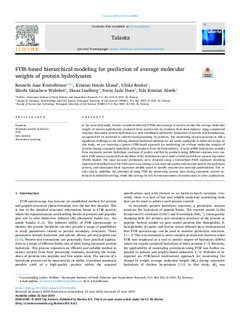| dc.contributor.author | Kristoffersen, Kenneth Aase | |
| dc.contributor.author | Liland, Kristian Hovde | |
| dc.contributor.author | Böcker, Ulrike | |
| dc.contributor.author | Wubshet, Sileshi Gizachhew | |
| dc.contributor.author | Lindberg, Diana | |
| dc.contributor.author | Horn, Svein Jarle | |
| dc.contributor.author | Afseth, Nils Kristian | |
| dc.date.accessioned | 2019-08-14T07:18:40Z | |
| dc.date.available | 2019-08-14T07:18:40Z | |
| dc.date.created | 2019-08-09T13:22:12Z | |
| dc.date.issued | 2019 | |
| dc.identifier.issn | 0039-9140 | |
| dc.identifier.uri | http://hdl.handle.net/11250/2608188 | |
| dc.description.abstract | In the presented study, Fourier-transform infrared (FTIR) spectroscopy is used to predict the average molecular weight of protein hydrolysates produced from protein-rich by-products from food industry using commercial enzymes. Enzymatic protein hydrolysis is a well-established method for production of protein-rich formulations, recognized for its potential to valorize food-processing by-products. The monitoring of such processes is still a significant challenge as the existing classical analytical methods are not easily applicable to industrial setups. In this study, we are reporting a generic FTIR-based approach for monitoring the average molecular weights of proteins during enzymatic hydrolysis of by-products from the food industry. A total of 885 hydrolysate samples from enzymatic protein hydrolysis reactions of poultry and fish by-products using different enzymes were studied. FTIR spectra acquired from dry-films of the hydrolysates were used to build partial least squares regression (PLSR) models. The most accurate predictions were obtained using a hierarchical PLSR approach involving supervised classification of the FTIR spectra according to raw material quality and enzyme used in the hydrolysis process, and subsequent local regression models tuned to specific enzyme-raw material combinations. The results clearly underline the potential of using FTIR for monitoring protein sizes during enzymatic protein hydrolysis in industrial settings, while also paving the way for measurements of protein sizes in other applications. | nb_NO |
| dc.language.iso | eng | nb_NO |
| dc.rights | Attribution-NonCommercial-NoDerivatives 4.0 Internasjonal | * |
| dc.rights.uri | http://creativecommons.org/licenses/by-nc-nd/4.0/deed.no | * |
| dc.title | FTIR-based hierarchical modeling for prediction of average molecular weights of protein hydrolysates | nb_NO |
| dc.type | Journal article | nb_NO |
| dc.type | Peer reviewed | nb_NO |
| dc.description.version | publishedVersion | nb_NO |
| dc.source.volume | 205 | nb_NO |
| dc.source.journal | Talanta: The International Journal of Pure and Applied Analytical Chemistry | nb_NO |
| dc.identifier.doi | 10.1016/j.talanta.2019.06.084 | |
| dc.identifier.cristin | 1715046 | |
| cristin.unitcode | 192,0,0,0 | |
| cristin.unitcode | 192,12,0,0 | |
| cristin.unitname | Norges miljø- og biovitenskapelige universitet | |
| cristin.unitname | Kjemi, bioteknologi og matvitenskap | |
| cristin.ispublished | true | |
| cristin.fulltext | original | |
| cristin.qualitycode | 1 | |

